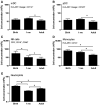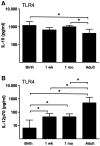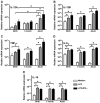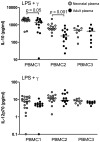Skewed pattern of Toll-like receptor 4-mediated cytokine production in human neonatal blood: low LPS-induced IL-12p70 and high IL-10 persist throughout the first month of life
- PMID: 19648060
- PMCID: PMC2892115
- DOI: 10.1016/j.clim.2009.07.003
Skewed pattern of Toll-like receptor 4-mediated cytokine production in human neonatal blood: low LPS-induced IL-12p70 and high IL-10 persist throughout the first month of life
Abstract
Newborns are highly susceptible to infectious diseases, which may be due to impaired immune responses. This study aims to characterize the ontogeny of neonatal TLR-based innate immunity during the first month of life. Cellularity and Toll-like receptor (TLR) agonist-induced cytokine production were compared between cord blood obtained from healthy neonates born after uncomplicated gestation and delivery (n=18), neonatal venous blood obtained at the age of one month (n=96), and adult venous blood (n=17). Cord blood TLR agonist-induced production of the Th1-polarizing cytokines IL-12p70 and IFN-alpha was generally impaired, but for TLR3, 7 and 9 agonists, rapidly increased to adult levels during the first month of life. In contrast, TLR4 demonstrated a slower maturation, with low LPS-induced IL-12p70 production and high IL-10 production up until the age of one month. Polarization in neonatal cytokine responses to LPS could contribute to neonatal susceptibility to severe bacterial infection.
Figures





References
-
- Rennie J. Robertson's Textbook of Neonatology. Churchill Livingstone; 2005.
-
- Adkins B, Leclerc C, Marshall-Clarke S. Neonatal adaptive immunity comes of age. Nat Rev Immunol. 2004;4:553–64. - PubMed
-
- Levy O. Innate immunity of the human newborn: distinct cytokine responses to LPS and other Toll-like receptor agonists. J Endotoxin Res. 2005;11:113–6. - PubMed
-
- Levy O. Innate immunity of the newborn: basic mechanisms and clinical correlates. Nat Rev Immunol. 2007;7:379–90. - PubMed
Publication types
MeSH terms
Substances
Grants and funding
LinkOut - more resources
Full Text Sources
Other Literature Sources
Medical

